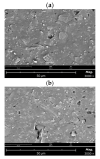A Study on Biofouling and Cleaning of Anion Exchange Membranes for Reverse Electrodialysis
- PMID: 35877900
- PMCID: PMC9316569
- DOI: 10.3390/membranes12070697
A Study on Biofouling and Cleaning of Anion Exchange Membranes for Reverse Electrodialysis
Abstract
This study covers the modification, (bio)fouling characterization, use, and cleaning of commercial heterogeneous anion exchange membranes (AEMs) to evaluate their feasibility for reverse electrodialysis (RED) applications. A surface modification with poly (acrylic) acid resulted in an improved monovalent perm-selectivity (decreased sulfate membrane transport rate). Moreover, we evaluated the (bio)fouling potential of the membrane using sodium dodecyl sulfate (SDS), sodium dodecyl benzenesulfonate (SDBS), and Aeromonas hydrophila as model organic foulants and a biofoulant, respectively. A detailed characterization of the AEMs (water contact angle, ion exchange capacity (IEC), scanning electron microscopy (SEM), cyclic voltammetry (CV), and Fourier Transform Infrared (FTIR) spectra) was carried out, verifying that the presence of such foulants reduces IEC and the maximum current obtained by CV. However, only SDS and SDBS affected the contact angle values. Cleaning of the biofouled membranes using a sodium hypochlorite aqueous solution allows for (partially) recovering their initial properties. Furthermore, this work includes a fouling characterization using real surface and sea water matrixes, confirming the presence of several types of fouling microorganisms in natural streams. A lower adhesion of microorganisms (measured in terms of total bacteria counts) was observed for the modified membranes compared to the unmodified ones. Finally, we propose a cleaning strategy to mitigate biofouling in AEMs that could be easily applied in RED systems for an enhanced long-term process performance.
Keywords: anion exchange membranes; biofouling; membrane cleaning; reverse electrodialysis.
Conflict of interest statement
The authors declare no conflict of interest.
Figures






Similar articles
-
Characterization of Poly(Acrylic) Acid-Modified Heterogenous Anion Exchange Membranes with Improved Monovalent Permselectivity for RED.Membranes (Basel). 2020 Jun 26;10(6):134. doi: 10.3390/membranes10060134. Membranes (Basel). 2020. PMID: 32604781 Free PMC article.
-
Mimicking the cell membrane: bio-inspired simultaneous functions with monovalent anion selectivity and antifouling properties of anion exchange membrane.Sci Rep. 2016 Nov 17;6:37285. doi: 10.1038/srep37285. Sci Rep. 2016. PMID: 27853255 Free PMC article.
-
Interaction mechanisms between fouling and chemical cleaning on the ageing behavior of ion-exchange membranes during electrodialysis treatment of flue gas desulfurization wastewater.Water Res. 2025 Mar 1;271:122897. doi: 10.1016/j.watres.2024.122897. Epub 2024 Nov 30. Water Res. 2025. PMID: 39647310
-
Surface Modifications of Anion Exchange Membranes for an Improved Reverse Electrodialysis Process Performance: A Review.Membranes (Basel). 2020 Jul 22;10(8):160. doi: 10.3390/membranes10080160. Membranes (Basel). 2020. PMID: 32707798 Free PMC article. Review.
-
A Review on Ion-Exchange Membranes Fouling during Electrodialysis Process in Food Industry, Part 2: Influence on Transport Properties and Electrochemical Characteristics, Cleaning and Its Consequences.Membranes (Basel). 2021 Oct 25;11(11):811. doi: 10.3390/membranes11110811. Membranes (Basel). 2021. PMID: 34832040 Free PMC article. Review.
Cited by
-
Anion Exchange Membrane Based on BPPO/PECH with Net Structure for Acid Recovery via Diffusion Dialysis.Int J Mol Sci. 2023 May 11;24(10):8596. doi: 10.3390/ijms24108596. Int J Mol Sci. 2023. PMID: 37239945 Free PMC article.
-
Stability of Ion Exchange Membranes in Electrodialysis.Membranes (Basel). 2022 Dec 31;13(1):52. doi: 10.3390/membranes13010052. Membranes (Basel). 2022. PMID: 36676859 Free PMC article. Review.
-
Fouling and Mitigation Behavior of Foulants on Ion Exchange Membranes with Surface Property in Reverse Electrodialysis.Membranes (Basel). 2023 Jan 13;13(1):106. doi: 10.3390/membranes13010106. Membranes (Basel). 2023. PMID: 36676913 Free PMC article.
References
-
- Gielen D., Gorini R., Wagner N., Leme R., Gutierrez L., Prakash G., Asmelash E., Janeiro L., Gallina G., Vale G. Global Energy Transformation: A Roadmap to 2050. International Renewable Energy Agency; Abu Dhabi, United Arab Emirates: 2018.
-
- Kempener R., Neumann F. Salinity Gradient Energy Technology Brief. IRENA and IMIEU; Abu Dhabi, United Arab Emirates: 2014.
-
- Mueller K.E., Thomas J.T., Johnson J.X., DeCarolis J.F., Call D.F. Life cycle assessment of salinity gradient energy recovery using reverse electrodialysis. J. Ind. Ecol. 2021;25:1194–1206. doi: 10.1111/jiec.13082. - DOI
-
- Gómez-Coma L., Abarca J.A., Fallanza M., Ortiz A., Ibáñez R., Ortiz I. Optimum recovery of saline gradient power using reversal electrodialysis: Influence of the stack components. J. Wat. Proc. Eng. 2022;48:102816. doi: 10.1016/j.jwpe.2022.102816. - DOI
Grants and funding
LinkOut - more resources
Full Text Sources

